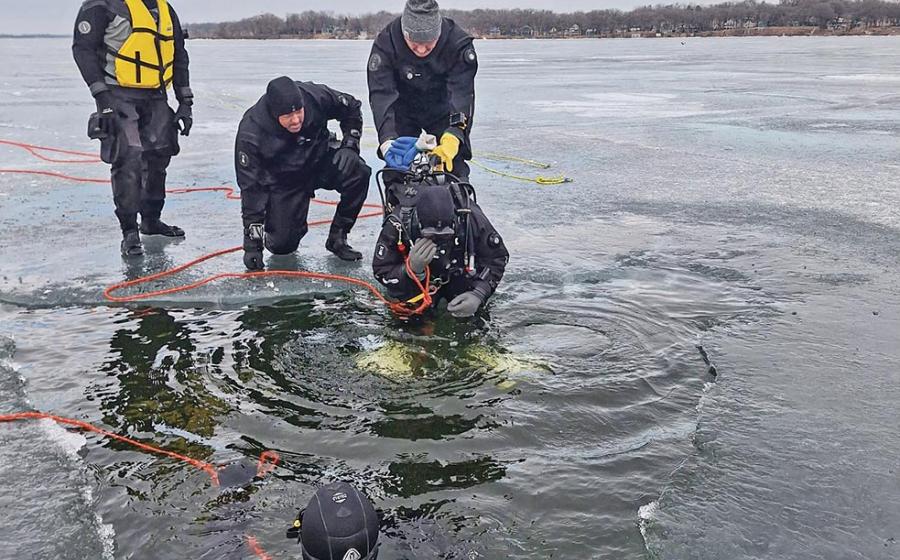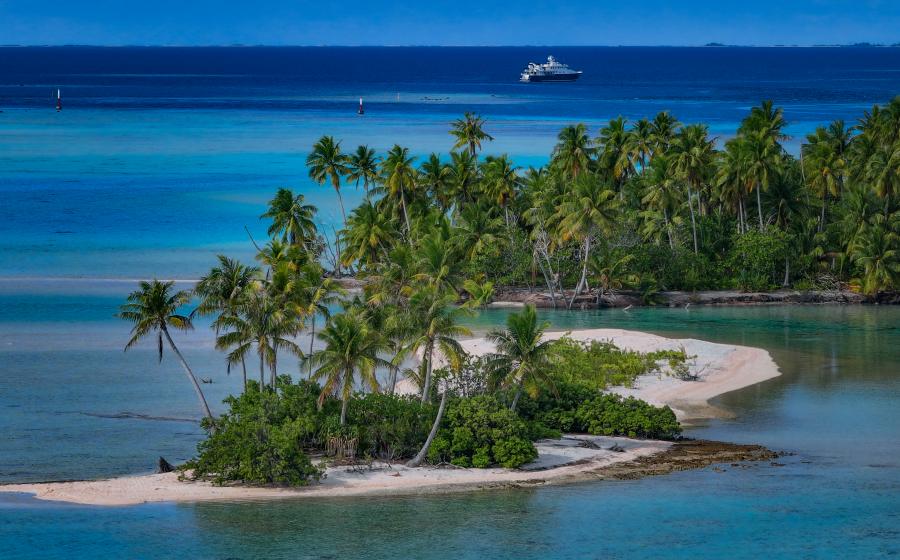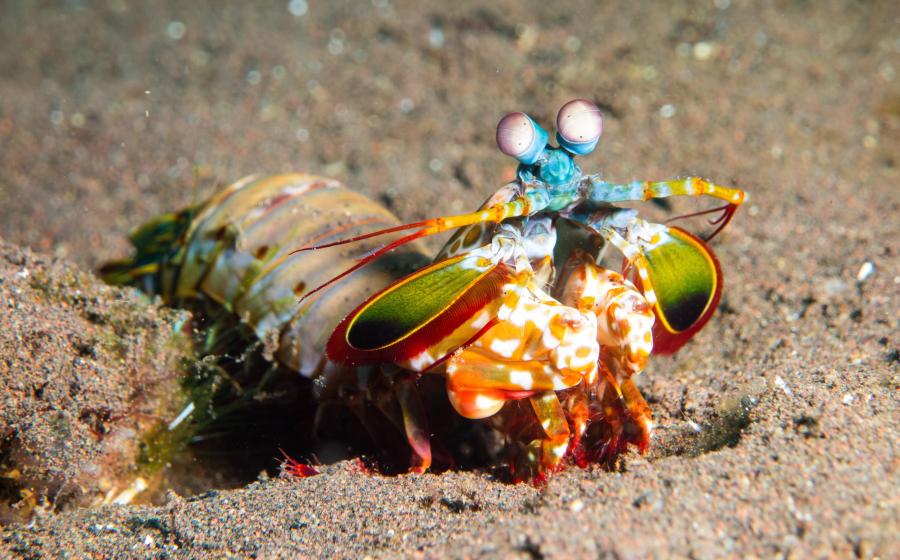Parting Shots
Septmeber 2003
By Selene Yeager
Every 12 seconds someone in the world dies from a mosquito-transmitted illness. Though that statistic likely conjures up images of sweaty trekkers covered with blood-sucking arthropods in Africa, these days you're nearly as likely to pick up a bug-borne disease in the Caribbean as you are in the Congo.
Though divers tend to stay in relatively clean and safe resort areas, they are far from immune from contracting illnesses. There were 40,000 cases of dengue fever in Tahiti alone during the outbreak of 2001. "Divers also have a risk profile that is a little different from regular tourists," says Eric L. Weiss, M.D., of the International Society of Travel Medicine. "They face all the general travel risks pertaining to food and water. On top of that, they are more exposed to the environmental hazards than your typical sightseers."
The key to staying safe, happy and healthy in even the most exotic locale is to research and become knowledgeable about local health risks. "Traveling is a wonderful, important experience," says Dr. Weiss. "The real risks are pretty small. We just want to take that little risk and make it almost nonexistent."
Do Your Homework
Six to eight weeks before your trip, start educating yourself on the health risks of the country you are visiting. What are the common diseases? What insects live there? Have there been any recent outbreaks that may affect you?
"Your first stop should be www.cdc.gov," says voracious scuba traveler Lewis Kohl, M.D., chairman of emergency medicine at Long Island College Hospital in Brooklyn, N.Y. At the Centers for Disease Control web site, you will find a region-by-region analysis, detailing the specific known risks, the recommended vaccinations and other advice for protecting yourself. Just click on "Travelers' Health" and look under "Destinations."
Next up: Talk to your travel doc, especially if you're going on an extended trip, which raises your risks. "The CDC is an excellent site, but it is limited. It can't speak to your specific risks, and it doesn't take into consideration what you'll be doing. Scuba diving is different from lounging poolside drinking rum and Cokes." If your primary care doctor isn't dive or travel savvy, check out the International Society of Travel Medicine at www.istm.org. There you'll find a listing of travel clinics you can call for complete info. Just click on "Travel Clinics Listings by Location" to find the one nearest you.
A Shot in the Arm
A recent British study found that one-fifth of vacationers who travel to exotic locales like Asia, Africa and Central America do so without getting proper immunizations. Experts say U.S. travelers are likely just as cavalier about their health. "Many people simply don't take the time to find out what precautions they should take," says Dr. Weiss.
Always check with your travel doc, because you may have special health needs, but here's the lowdown on the CDC's recommended shots for popular diving destinations around the globe, including Caribbean, Central American, South Pacific, North African and Southeast Asian locales. Be sure to get your immunizations four to six weeks before your trip, so they have time to take effect.
> Hepatitis A or immune globulin. Get this shot if you're going anywhere there might be questionable sanitation. Hep A is a highly contagious, miserable liver disease found around the world.
> Hepatitis B. You'll need this one only if you're staying longer than six months, if you plan to have sex with the local population or if you might be exposed to blood.
> Rabies. Don't worry about this one unless there's a chance you might be around wild animals; dive buddies not included.
> Typhoid. This one is a good idea if you are visiting developing countries. It's not needed for Australia or New Zealand, but it's a must-have for Southeast Asian locales like Indonesia, Malaysia, the Philippines and Thailand, where antibiotic-resistant strains exist.
> Yellow fever. This one is recommended for travelers who plan to venture beyond urban areas in Trinidad, Tobago and Panama.
> Japanese encephalitis. Get this one if you plan to visit rural areas in any part of Southeast Asia for more than four weeks.
> Tetanus-diphtheria and measles. Booster immunizations are recommended everywhere, as needed.
> Polio. One-time dose recommended for African, South Pacific and Southeast Asian destinations.
A Bug's Life
Insect protection is a must when you travel, says Dr. Kohl. "The world is filled with bizarre diseases you can contract from a single insect bite." Here are the top 10 that dwell in and around popular dive destinations.
> Dengue. A severe, flu-like illness also known as "breakbone fever" delivered by infected day-biting mosquitoes. (Mexico, Central America, Caribbean, North Africa, Southeast Asia, South Pacific)
> Malaria. A serious flu-like and sometimes fatal infection that is carried by mosquitoes. Once you've been bitten, the parasites enter your bloodstream and set up shop in your liver, where they grow and multiply. (Mexico, Central America, Caribbean, North Africa, Southeast Asia, South Pacific)
> Filariasis. A lymphatic infection transmitted by mosquitoes. The bite transmits microscopic worms into your bloodstream that take up residence in your lymph nodes and vessels. (Mexico, Central America, Caribbean, North Africa, Southeast Asia, South Pacific)
> Leishmaniasis. Mild forms cause sometimes painful skin infections. More serious strains of the disease infect internal organs like the spleen and liver. Transmitted by infected sand fleas. (Mexico, Central America, Caribbean, North Africa)
> Schistosomiasis. Parasitic worm disease that can cause flu-like symptoms. The parasites are carried by infected snails and released into freshwater bodies, where they penetrate the skin of unsuspecting waders. (Caribbean, North Africa, Southeast Asia)
> Onchocerciasis. Also known as "river blindness." Transmitted by infected black flies, which deposit worms into the bloodstream of their bite victims. The worms grow up and wreak havoc, including impaired vision, blindness and severe skin disease. (Mexico, Central America, North Africa)
> Plague. A potentially serious flu-like disease transmitted by rodent flea bites or by handling infected animals. (Southeast Asia)
> Japanese encephalitis. A mosquito-borne virus that attacks the central nervous system, and can cause flu-like symptoms, paralysis and potentially fatal brain infection. (Southeast Asia)
> Chagas disease. An infection marked by flu-like symptoms, fatigue, rash and swelling, caused by reduviid or "kissing bugs." The infected bug defecates on you, and you unknowingly rub the feces into a cut, your eyes or mouth. (Mexico, Central America)
> Yellow fever. This is a potentially serious flu-like virus transmitted by infected mosquitoes. (Central America, certain parts of the Caribbean)
Though there are some vaccinations and medications for these bug-borne diseases, your best protection against nearly all these infections is DEET. "Forget worrying about the risks of DEET," implores Dr. Weiss. "More than 100 million people use it every year, and there's only been a handful of complications reported from it." Apply it always--not just during "mosquito hours," because diseases like dengue are spread during the day, even in urban areas.
To avoid water-dwelling parasites, don't swim in fresh water that might be contaminated in regions where onchocerciasis and schistosomiasis are known to live.
When To Worry
Mild symptoms can mean major illness when you're traveling abroad. Though you can usually manage a bout of traveler's diarrhea on your own, anything more serious requires medical care. See a doctor ASAP if you develop any of the following:
-
Fever
-
Severe headache, especially if you also have a fever
-
Rash, especially with a fever
-
Disorientation
-
Diarrhea that's bloody or accompanied by sharp pain
-
Flu-like symptoms, including muscle ache, fatigue and fever
Septmeber 2003
By Selene Yeager
Every 12 seconds someone in the world dies from a mosquito-transmitted illness. Though that statistic likely conjures up images of sweaty trekkers covered with blood-sucking arthropods in Africa, these days you're nearly as likely to pick up a bug-borne disease in the Caribbean as you are in the Congo.
Though divers tend to stay in relatively clean and safe resort areas, they are far from immune from contracting illnesses. There were 40,000 cases of dengue fever in Tahiti alone during the outbreak of 2001. "Divers also have a risk profile that is a little different from regular tourists," says Eric L. Weiss, M.D., of the International Society of Travel Medicine. "They face all the general travel risks pertaining to food and water. On top of that, they are more exposed to the environmental hazards than your typical sightseers."
The key to staying safe, happy and healthy in even the most exotic locale is to research and become knowledgeable about local health risks. "Traveling is a wonderful, important experience," says Dr. Weiss. "The real risks are pretty small. We just want to take that little risk and make it almost nonexistent."
Do Your Homework
Six to eight weeks before your trip, start educating yourself on the health risks of the country you are visiting. What are the common diseases? What insects live there? Have there been any recent outbreaks that may affect you?
"Your first stop should be www.cdc.gov," says voracious scuba traveler Lewis Kohl, M.D., chairman of emergency medicine at Long Island College Hospital in Brooklyn, N.Y. At the Centers for Disease Control web site, you will find a region-by-region analysis, detailing the specific known risks, the recommended vaccinations and other advice for protecting yourself. Just click on "Travelers' Health" and look under "Destinations."
Next up: Talk to your travel doc, especially if you're going on an extended trip, which raises your risks. "The CDC is an excellent site, but it is limited. It can't speak to your specific risks, and it doesn't take into consideration what you'll be doing. Scuba diving is different from lounging poolside drinking rum and Cokes." If your primary care doctor isn't dive or travel savvy, check out the International Society of Travel Medicine at www.istm.org. There you'll find a listing of travel clinics you can call for complete info. Just click on "Travel Clinics Listings by Location" to find the one nearest you.
A Shot in the Arm
A recent British study found that one-fifth of vacationers who travel to exotic locales like Asia, Africa and Central America do so without getting proper immunizations. Experts say U.S. travelers are likely just as cavalier about their health. "Many people simply don't take the time to find out what precautions they should take," says Dr. Weiss.
Always check with your travel doc, because you may have special health needs, but here's the lowdown on the CDC's recommended shots for popular diving destinations around the globe, including Caribbean, Central American, South Pacific, North African and Southeast Asian locales. Be sure to get your immunizations four to six weeks before your trip, so they have time to take effect.
> Hepatitis A or immune globulin. Get this shot if you're going anywhere there might be questionable sanitation. Hep A is a highly contagious, miserable liver disease found around the world.
> Hepatitis B. You'll need this one only if you're staying longer than six months, if you plan to have sex with the local population or if you might be exposed to blood.
> Rabies. Don't worry about this one unless there's a chance you might be around wild animals; dive buddies not included.
> Typhoid. This one is a good idea if you are visiting developing countries. It's not needed for Australia or New Zealand, but it's a must-have for Southeast Asian locales like Indonesia, Malaysia, the Philippines and Thailand, where antibiotic-resistant strains exist.
> Yellow fever. This one is recommended for travelers who plan to venture beyond urban areas in Trinidad, Tobago and Panama.
> Japanese encephalitis. Get this one if you plan to visit rural areas in any part of Southeast Asia for more than four weeks.
> Tetanus-diphtheria and measles. Booster immunizations are recommended everywhere, as needed.
> Polio. One-time dose recommended for African, South Pacific and Southeast Asian destinations.
A Bug's Life
Insect protection is a must when you travel, says Dr. Kohl. "The world is filled with bizarre diseases you can contract from a single insect bite." Here are the top 10 that dwell in and around popular dive destinations.
> Dengue. A severe, flu-like illness also known as "breakbone fever" delivered by infected day-biting mosquitoes. (Mexico, Central America, Caribbean, North Africa, Southeast Asia, South Pacific)
> Malaria. A serious flu-like and sometimes fatal infection that is carried by mosquitoes. Once you've been bitten, the parasites enter your bloodstream and set up shop in your liver, where they grow and multiply. (Mexico, Central America, Caribbean, North Africa, Southeast Asia, South Pacific)
> Filariasis. A lymphatic infection transmitted by mosquitoes. The bite transmits microscopic worms into your bloodstream that take up residence in your lymph nodes and vessels. (Mexico, Central America, Caribbean, North Africa, Southeast Asia, South Pacific)
> Leishmaniasis. Mild forms cause sometimes painful skin infections. More serious strains of the disease infect internal organs like the spleen and liver. Transmitted by infected sand fleas. (Mexico, Central America, Caribbean, North Africa)
> Schistosomiasis. Parasitic worm disease that can cause flu-like symptoms. The parasites are carried by infected snails and released into freshwater bodies, where they penetrate the skin of unsuspecting waders. (Caribbean, North Africa, Southeast Asia)
> Onchocerciasis. Also known as "river blindness." Transmitted by infected black flies, which deposit worms into the bloodstream of their bite victims. The worms grow up and wreak havoc, including impaired vision, blindness and severe skin disease. (Mexico, Central America, North Africa)
> Plague. A potentially serious flu-like disease transmitted by rodent flea bites or by handling infected animals. (Southeast Asia)
> Japanese encephalitis. A mosquito-borne virus that attacks the central nervous system, and can cause flu-like symptoms, paralysis and potentially fatal brain infection. (Southeast Asia)
> Chagas disease. An infection marked by flu-like symptoms, fatigue, rash and swelling, caused by reduviid or "kissing bugs." The infected bug defecates on you, and you unknowingly rub the feces into a cut, your eyes or mouth. (Mexico, Central America)
> Yellow fever. This is a potentially serious flu-like virus transmitted by infected mosquitoes. (Central America, certain parts of the Caribbean)
Though there are some vaccinations and medications for these bug-borne diseases, your best protection against nearly all these infections is DEET. "Forget worrying about the risks of DEET," implores Dr. Weiss. "More than 100 million people use it every year, and there's only been a handful of complications reported from it." Apply it always--not just during "mosquito hours," because diseases like dengue are spread during the day, even in urban areas.
To avoid water-dwelling parasites, don't swim in fresh water that might be contaminated in regions where onchocerciasis and schistosomiasis are known to live.
When To Worry
Mild symptoms can mean major illness when you're traveling abroad. Though you can usually manage a bout of traveler's diarrhea on your own, anything more serious requires medical care. See a doctor ASAP if you develop any of the following:
Fever
Severe headache, especially if you also have a fever
Rash, especially with a fever
Disorientation
Diarrhea that's bloody or accompanied by sharp pain
Flu-like symptoms, including muscle ache, fatigue and fever






